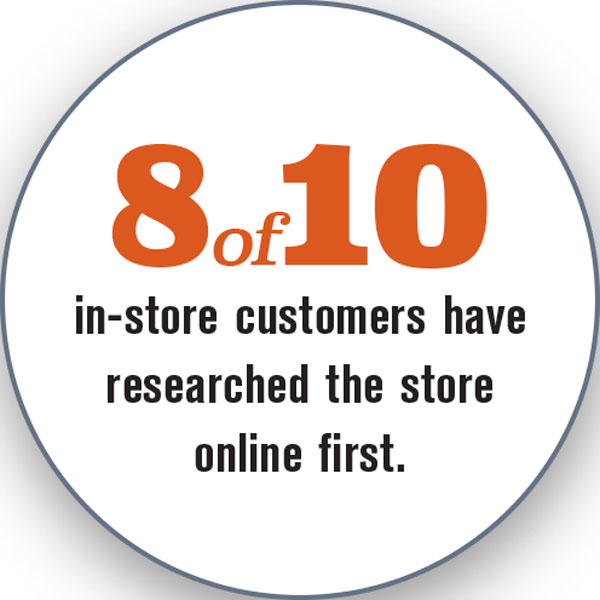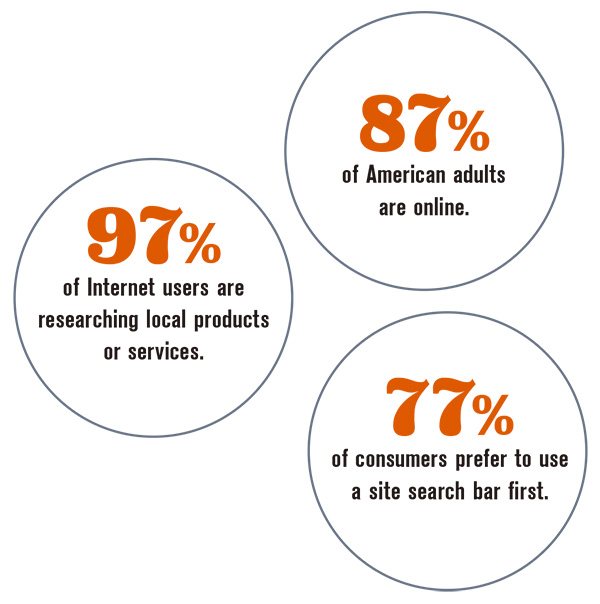Most all Americans are online. Are they finding you? According to Pew Research Center, as of January 2014, 87 percent of American adults are online. Of those Internet users, 97 percent use the Internet to research products or services in their community. If those users can’t find you online, chances are slim they will be visiting your store. According to GE Capital Retail research, 8 of 10 customers who make an in-store purchase have researched the store online first. Are you getting the most out of these research online, buy offline (ROBO) shoppers?
How People Shop
With more than 80 percent of your customers researching online before ever buying in your store, it is imperative that your website effectively direct customers in the right direction. If they cannot easily locate what they need, they will find it somewhere else.

Think of your website like a newspaper. Newspapers put the most important information on the front page of the paper above the fold. This allows the headlines to attract buyers and readers. Your site needs to have the most relevant information on the home page, above the fold (the area people see on the screen when they first get to your website). This entices readers to dig further. The most popular way for consumers to find the products you sell is by using a site search bar. According to a 2012 Cyber Monday study from Google, 77 percent of consumers preferred to use a site search bar first to find what they are looking for. Companies like Google, Amazon and eBay have so encouraged this behavior that it has become ingrained in the consumer consciousness. Site search is only as good as the functionality and content behind it. When customers search for walkers by typing the word into your search bar, they should not only receive a list of products related to walkers, but also have the ability to further refine those results by price, type, brand and sale, allowing consumers to customize their search. The site search bar acts like an extension of your sales team. When someone walks into your brick-and-mortar store, a salesperson greets them and asks, “How can I help you today?” Once the customer lets your salesperson know what they are looking for, they are guided to the area of your store that has those products displayed. While walking that direction, the salesperson asks qualifying questions so they can refine the products they present to the customer to the best few possible matches.

Does your website offer that same level of service? If you don’t have a search bar, don’t deliver relevant results and don’t offer the tools shoppers expect to refine their search results your customers will get frustrated and go to another website to do their research. Now consider how to reach the other 23 percent of your online consumers. The same principles apply—make the site user-friendly and easy to use, represent your product selection and services accurately, and give customers what they need from their online interaction with your business. When developing your site, it is important to consider your whole audience. Whether shoppers gravitate to a site search bar, or whether they simply browse the site, there or a few universal focus areas that will help you keep their attention. Product type or category—Allow shoppers to easily find the product categories you sell. From wheelchairs to daily living aids to scooters, your site needs to have all of the categories for the products you offer, or customers will assume you do not carry them. The information behind those categories (subcategories, company names, etc.) must be substantial to allow clients to keep narrowing their search. Brand—Many customers search sites by the brand of the product they are looking for. Allow searches by brand and encourage the use of brand logos on your home page. Featured products—Consumers always like to see what’s new. Big-box stores do a great job of featuring hot sellers and new products on their home page; develop your site the same way. In-store promotions—Consumers like savings and will do their research to find good deals. Your website should have sale items to grab their focus and direct them to take action. Another great attention getter to is a clearance bin or a daily, weekly or monthly deal. By creating this type of sale area on your website, you can train your customers to come back periodically. Ultimately, online presence is becoming more important than physical location when it comes to showcasing inventory. Take some time to research your own website to see how your customers can find what you sell. If your site does not allow your customers to find what they are looking for, they will go somewhere else. If your site isn’t delivering, it’s time to redevelop with these goals in mind:

Branding
When customers arrive at your home page, you have 10 seconds to convince them to stay. If your site does not follow your branding and show them your worth in their search, they will move on.
Complete and Accurate Data
Product information on your site should reflect the most up-to-date inventory, specifications and pricing. It is also important to showcase every product and service you offer. For customers online, if it isn’t on your website, you might as well not offer it.
Communication
Help your customers communicate with you. Place your address and phone number within the header on every page. Make your contact forms easily accessible on your site, and on every product and service page. Your location information should also offer a map and driving directions. All of these details will help your customers to actually complete their transaction with you. Whether that happens over the phone, in your store or online doesn’t matter, but getting your customers to that point does. Most of the items you sell will still be purchased inside your store, as your customers need to be educated on what they should buy. They want to talk to a professional to guide them in making the right decision. Your online presence needs to mirror everything about your business and the customer experience that can be found in your physical store. Take a hard look at your site to see if it can perform to the standard your customers need in today’s digital world. If it doesn’t, you must make a change, or you will be sending your customers to do business elsewhere. You have put a lot of effort into building a solid reputation; don’t let a poorly designed website negate that. This article is the fourth of a 12-part series on digital sales and marketing. Each segment focuses on online solutions and provides the insight and resources necessary to be successful in this area of business. Read all the articles in this series at homecaremag.com/digital-sales-marketing-2015
